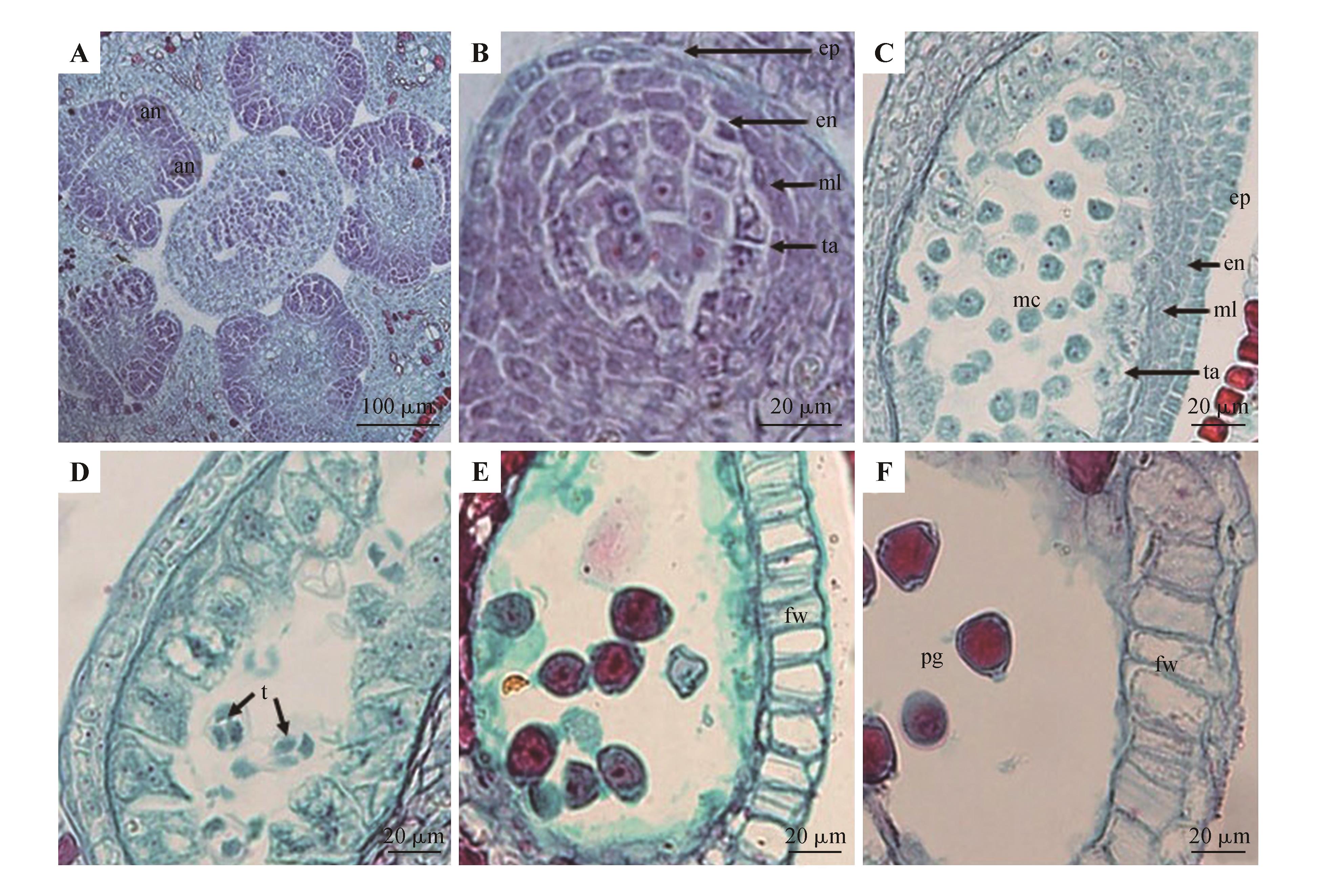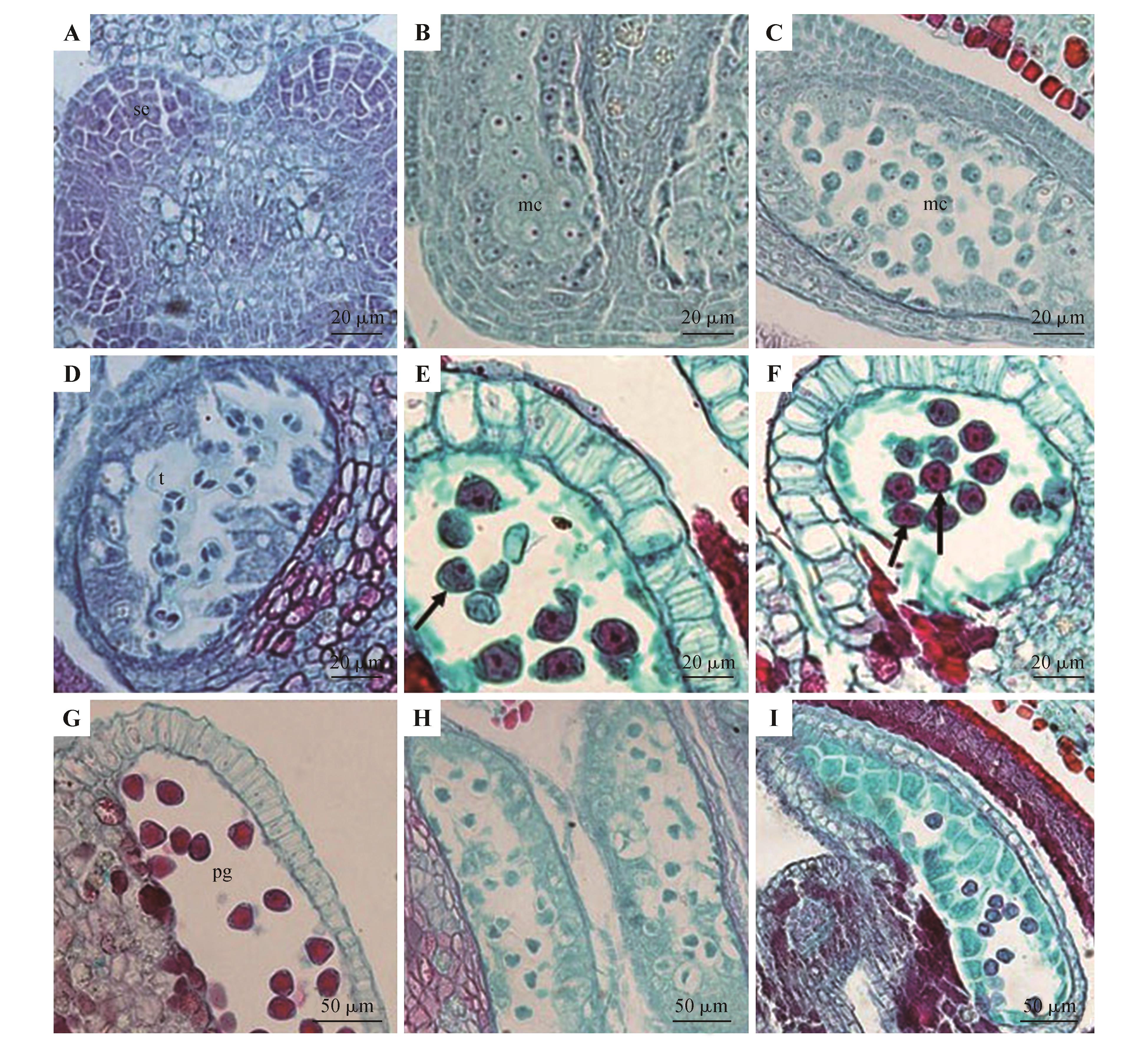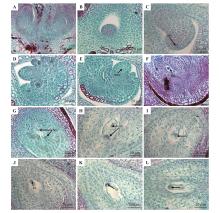Bulletin of Botanical Research ›› 2024, Vol. 44 ›› Issue (5): 662-669.doi: 10.7525/j.issn.1673-5102.2024.05.003
• Plant reproductive biology • Previous Articles Next Articles
Kangxin WANG1, Shiqin WANG1, Yimin WANG2, Zhijie CHENG1, Faju CHEN1, Yubing WANG1( )
)
Received:2023-10-17
Online:2024-09-20
Published:2024-09-23
Contact:
Yubing WANG
E-mail:tomswfc1977@163.com
CLC Number:
Kangxin WANG, Shiqin WANG, Yimin WANG, Zhijie CHENG, Faju CHEN, Yubing WANG. Megasporogensis, Microsporogenesis and Development of Male and Female Gametophytes of Endangered Berchemiella wilsonii[J]. Bulletin of Botanical Research, 2024, 44(5): 662-669.
Add to citation manager EndNote|Ris|BibTeX
URL: https://bbr.nefu.edu.cn/EN/10.7525/j.issn.1673-5102.2024.05.003

Fig.1
Anther wall development of B. wilsoniiA.Anther transverse section,showing four microsporangia;B.The sporogonia divide to form anther walls,which shows mononuclear or multinucleate tapetum cells;C.During meiosis of microspore mother cells,the middle layer and tapetum began to disintegrate;D.At tetrad stage,the cells in the middle layer were flattened linearly;E.Binucleate phase;F.Mature pollen grains,fibrous thickened endothecium;an.Anther;ep.Epidermis;en.Inner wall of anther chamber;ml.Middle layer;ta.Tapetum;fw.Fibrous thickened inner wall of anther chamber;mc.Microspore mother cell;t.Tetrad;pg.Pollen grains.


Fig.2
Microsporogenesis and male gametophyte development of B. wilsoniiA.The sporogonia divide to form anther wall and secondary cells;B.Early microspore mother cells;C.Meiosis stage of microspore mother cell;D.Tetrad period;E.Mononuclear pollen grains(arrow);F.Binucleate phase(arrow);G.Mature pollen grains;H.In the prophase of tetrad formation,the tapetum was disintegrated in advance;I.Abnormal pollen grains(delayed degradation of tapetum);sc.Secondary sporogenesis cells;mc.Microspore mother cells;t.Tetrad;pg.Pollen grains.


Fig.3
Megasporogenesis and female gametophyte development of B. wilsoniiA. Ovary longitudinal section; B. Ovule primordium; C. Female sporogonia; D. Anatropous ovule, showing integument and thick nucellus; E. The megaspore mother cell; F. Functional megaspore; G. Binucleate embryo sac; H-I. The upper and lower polar nuclei in the egg apparatus and central cell; J. An egg cell; K. Two synergids; L. Antipodal cells. Abbreviation: asc. sporogonium; ii. The inner integument; oi. The outer integument; mmc. The megaspore mother cell; fm. The functional megaspore; bes. Binucleate embryo sac; ac. Antipodal cell; cc. Central cell; ec. Egg cell; sy. Synergids.

| 1 | 陈艺林.中国植物志:第48卷:第1分册[M].北京: 科学出版社,1982:104-106. |
| CHEN Y L.Flora of China:Vol.48:Part 1[M].Beijing:Science Press,1982:104-106. | |
| 2 | 钱宏.东亚特有属:小勾儿茶属的研究[J].植物研究,1988,8(4):119-128. |
| QIAN H.A study on the (Rhamnaceae) cenus Berchemiella Nakai endemic to East Asia[J].Bulletin of Botanical Research,1988,8(4):119-128. | |
| 3 | LI J Q, JIANG M X, WANG H C,et al.Rediscovery of Berchemiella wilsonii(Schneid.) Nakai(Rhamnaceae),an endangered species from Hubei,China[J].Acta Phytotaxonomica Sinica,2004,42(1):86-88. |
| 4 | 甘啟良,关良福.十八里长峡自然保护区国家级保护植物研究[J].中国野生植物资源,2007,26(1):8-11. |
| GAN Q L, GUAN L F.Study on national-level protected plants in Shibali Changxia Nature Reserve[J].Chinese Wild Plant Resources,2007,26(1):8-11. | |
| 5 | 李华东,丁建林,何晓.浙江嵊州发现濒危树种小勾儿茶[J].浙江农林大学学报,2012,29(4):639-640. |
| LI H D, DING J L, HE X. Berchemiella wilsonii:a new Zhejiang discovered in plant record from Shengzhou[J].Journal of Zhejiang A&F University,2012,29(4):639-640. | |
| 6 | 郜二虎,汪正祥,王志臣.湖北堵河源自然保护区科学考察与研究[M].北京:科学出版社,2012. |
| GAO E H, WANG Z X, WANG Z C.Scientific investigation and research in Hubei Duheyuan Nature Reserve[M].Beijing:Science Press,2012. | |
| 7 | 王瑞江,刘演,陈世龙.湖北省珍稀濒危植物[M].北京:科学出版社,2017:103. |
| WANG R J, LIU Y, CHEN S L.Rare and endangered plants in Hubei[M].Beijing:Science Press,2017:103. | |
| 8 | 国政,臧润国.中国极小种群野生植物濒危程度评价指标体系[J].林业科学,2013,49(6):10-17. |
| GUO Z, ZANG R G.Evaluation index system of endangered levels of the wild plants with tiny population in China[J].Scientia Silvae Sinicae,2013,49(6):10-17. | |
| 9 | 胡理乐,江明喜,黄汉东,等.濒危植物小勾儿茶伴生群落特征研究[J].武汉植物学研究,2003,21(4):327-331. |
| HU L Y, JIANG M X, HUANG H D,et al.Studies on traits of concomitant community of endangered plant Berchemiella wilsonii [J].Journal of Wuhan Botanical Research,2003,21(4):327-331. | |
| 10 | 韦若勋,张志耘,陈艺林,等.勾儿茶属和小勾儿茶属(鼠李科)的果实及种子形态研究及其系统学意义[J].广西植物,2014,34(5):589-595. |
| WEI R X, ZHANG Z Y, CHEN Y L,et al.Drup and seed morphology of the Berchemia and Berchemiella(Rhamnaceae) and its systematic significance[J].Guihaia,2014,34(5):589-595. | |
| 11 | LI Y Y, WANG J Q, LI P,et al.The complete chloroplast genome sequence of Berchemiella wilsonii(Rhamnaceae),an endangered endemic species[J].Mitochondrial DNA Part B,2019,4(1):452-454. |
| 12 | 刘赛.小勾儿茶引种栽培试验初报[J].湖北林业科技,2018,47(3):15-16. |
| LIU S.Preliminary report on introduction and cultivation experiment of Berchemiella wilsonii [J].Hubei Forestry Science and Technology,2018,47(3):15-16. | |
| 13 | 高润梅.珍稀濒危植物的胚胎学研究进展[J].山西农业大学学报(自然科学版),2002,22(3):239-245. |
| GAO R M.Study and improvement on embrygology of rare and endangered plants[J].Journal of Shanxi Agricultural University(Natural Science Edition),2002,22(3):239-245. | |
| 14 | 李正理.植物组织制片学[M].北京:北京大学出版社,1996. |
| LI Z L.Organization production of plant[M].Beijing:Peking University Press,1996. | |
| 15 | 黄飞逸,豆苏含,张亚东,等.冬枣大小孢子发生及雌雄配子体发育[J].核农学报,2017,31(10):1913-1920. |
| HUANG F Y, DOU S H, ZHANG Y D,et al.Megasporogenesis, microsporogenesis and development of female and male gametophytes of Ziziphus jujuba Mill. cv. Dongzao[J].Journal of Nuclear Agricultural Sciences,2017,31(10):1913-1920. | |
| 16 | 邵凤侠.南方鲜食枣胚败育机理研究[D].长沙:中南林业科技大学,2019. |
| SHAO F X.Research on the mechanism of embryo abortion of southern China fresh-eat jujube[D].Changsha:Central South University of Forestry and Technology,2019. | |
| 17 | 杨如梦,汪加魏,孙荣喜,等.南酸枣大小孢子发生及雌雄配子体发育过程研究[J].林业科学研究,2023,36(3):109-118. |
| YANG R M, WANG J W, SUN R X,et al.Megasporogenesis, microsporogenesis and development of female and male gametophyte of Choerospondias axillaris [J].Forest Research,2023,36(3):109-118. | |
| 18 | 许小连.濒危植物羊角槭生殖生物学的初步研究[D].杭州:浙江农林大学,2012. |
| XU X L.A preliminary study on reproductive biology of the endangered plant Acer yanjuechi Fang et P.L.Chiu[D].Hangzhou:Zhejiang A&F University,2012. | |
| 19 | 曹小勇.濒危植物庙台槭生殖生物学研究:Ⅱ.大小孢子发生和雌雄配子体发育[J].汉中师范学院学报(自然科学),1999,17(1):50-54. |
| CAO X Y.Studies on the reproductive biology of a China rare plant- Acer miaotaiense:Ⅱ.Megasporogenesis miscrosporogenesis and development of female and male gametophyte[J].Journal of Hanzhong Normal University(Natural Science),1999,17(1):50-54. | |
| 20 | 赵兴峰,孙卫邦,杨华斌,等.极度濒危植物西畴含笑的大小孢子发生及雌雄配子体发育[J].云南植物研究,2008,30(5):549-556. |
| ZHAO X F, SUN W B, YANG H B,et al.Mega- and microsporogenesis and development of female and male gametophytes of Michelia coriacea(Magnoliaceae),a globally critical endangered plant in South-East Yunnan of China[J].Acta Botanica Yunnanica,2008,30(5):549-556. | |
| 21 | ZHANG D D, LIU D, LV X M,et al.The cysteine protease CEP1,a key executor involved in tapetal programmed cell death,regulates pollen development in Arabidopsis [J].The Plant Cell,2014,26(7):2939-2961. |
| 22 | 王玖瑞,刘玲,刘孟军,等.枣树雄性不育新种质的获得[J].园艺学报,2006,33(2):374-377. |
| WANG J R, LIU L, LIU M J,et al.Acquirement of new male sterile germplasm of Chinese jujube[J].Acta Horticulturae Sinica,2006,33(2):374-377. | |
| 23 | 杨艺,王娜,王奎玲,等.大叶铁线莲大小孢子发生及雌雄配子体发育[J].植物学报,2019,54(5):596-605. |
| YANG Y, WANG N, WANG K L,et al.Megasporogenesis, microsporogenesis and development of male and female gametophytes of Clematis heracleifolia [J].Chinese Bulletin of Botany,2019,54(5):596-605. | |
| 24 | 王姗,沈永宝,鲍华鹏,等.宝华玉兰大小孢子发生和雌雄配子体发育过程中解剖结构的变化[J].植物资源与环境学报,2021,30(3):46-53. |
| WANG S, SHEN Y B, BAO H P,et al.Change of anatomical structure in the process of mega- and microsporogenesis and female and male gametophyte development of Yulania zenii [J].Journal of Plant Resources and Environment,2021,30(3):46-53. | |
| 25 | 马庆华,续九如,王贵禧,等.枣树杂交育种研究进展[J].中国农学通报,2008,24(11):174-178. |
| MA Q H, XU J R, WANG G X,et al.Progress on hybrid breeding of Chinese jujube(Ziziphus jujuba Mill.)[J].Chinese Agricultural Science Bulletin,2008,24(11):174-178. | |
| 26 | GLEISER G, VERDÚ M, SEGARRA-MORAGUES J G,et al.Disassortative mating,sexual specialization,and the evolution of gender dimorphism in heterodichogamous Acer opalus [J].Evolution,2008,62(7):1676-1688. |
| 27 | 张静文,陈慧,李燕华,等.濒危半红树植物莲叶桐的开花生物学特征及繁育系统[J].生态学杂志,2024,43(5):1243-1248. |
| ZHANG J W, CHEN H, LI Y H,et al.Flower phenology and breeding system of endangered semi-mangrove Hernandia nymphaeifolia [J].Chinese Journal of Ecology,2024,43(5):1243-1248. | |
| 28 | 陈兴银,张玉晶,张凯凯,等.濒危植物珙桐大小孢子形成和雌雄配子体发育观察[J].山地农业生物学报,2016,35(6):35-39. |
| CHEN X Y, ZHANG Y J, ZHANG K K,et al.The megasporogenesis and microsporogensis and development of female and male gametophyte of endangered plants Davidia involucrate [J].Journal of Mountain Agriculture and Biology,2016,35(6):35-39 | |
| 29 | 施慧嫒,陈发菊,梁宏伟,等.濒危植物瑶山苣苔的大小孢子发生和雌雄配子体发育研究[J].植物研究,2021,41(3):329-335. |
| SHI H A, CHEN F J, LIANG H W,et al.Sporogenesis and gametogenesis on endangered Dayaoshania cotinifolia [J].Bulletin of Botanical Research,2021,41(3):329-335. | |
| 30 | 白洁,周涛,马江,等.三叶木通大小孢子发生和雌雄配子体发育研究[J].植物研究,2022,42(6):946-955. |
| BAI J, ZHOU T, MA J,et al.Sporogenesis and gametogenesis of Akebia trifoliata [J].Bulletin of Botanical Research,2022,42(6):946-955. |
| [1] | Jie BAI, Tao ZHOU, Jiang MA, Wen LIU, Zhiguo JIANG, Faju CHEN. Sporogenesis and Gametogenesis of Akebia trifoliata [J]. Bulletin of Botanical Research, 2022, 42(6): 946-955. |
| [2] | ZHU Li-Qiong, YUAN Juan, WEI Li-Di, WEI Yan-Chun, ZHAO Li-Jun. Sporogenesis and Gametogenesis of Lagerstroemia speciosa [J]. Bulletin of Botanical Research, 2018, 38(2): 182-188. |
| [3] | ZHENG Jing-Yuan, LI Yun-Zeng, ZHOU Cui-Cui, LU Yun-Shen, WANG Xiu-Hua. Study on Embryology of Ulmus pumila L. [J]. Bulletin of Botanical Research, 2017, 37(5): 651-657. |
| [4] | LI Lu, ZHANG Zi-Yuan, KONG Dong-Rui, PENG Hua. Anther and Young Ovule Development in Clematoclethra(Actinidiaceae) with Taxonomic Implications [J]. Bulletin of Botanical Research, 2017, 37(4): 508-513. |
| [5] | Li Shi-weng, Tu Li-zhu. THE EMBRYOLOGY AND IT'S SYSTEMATIC SIGNIFICANCE OF NITRARIA [J]. Bulletin of Botanical Research, 1994, 14(3): 255-262. |
| Viewed | ||||||
|
Full text |
|
|||||
|
Abstract |
|
|||||